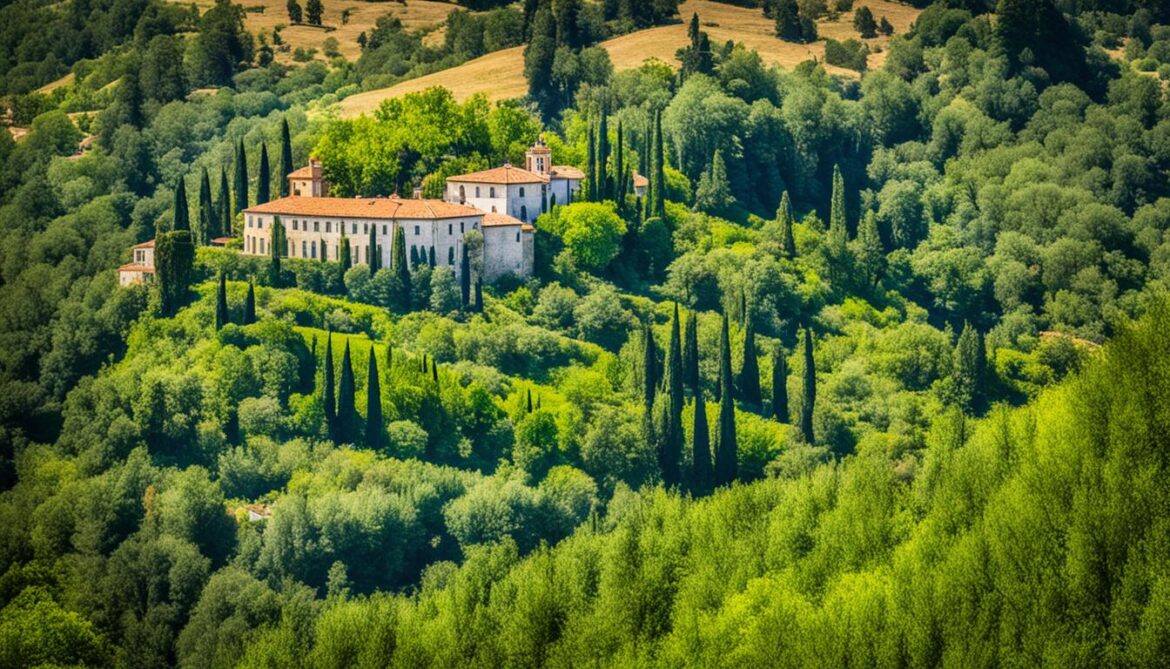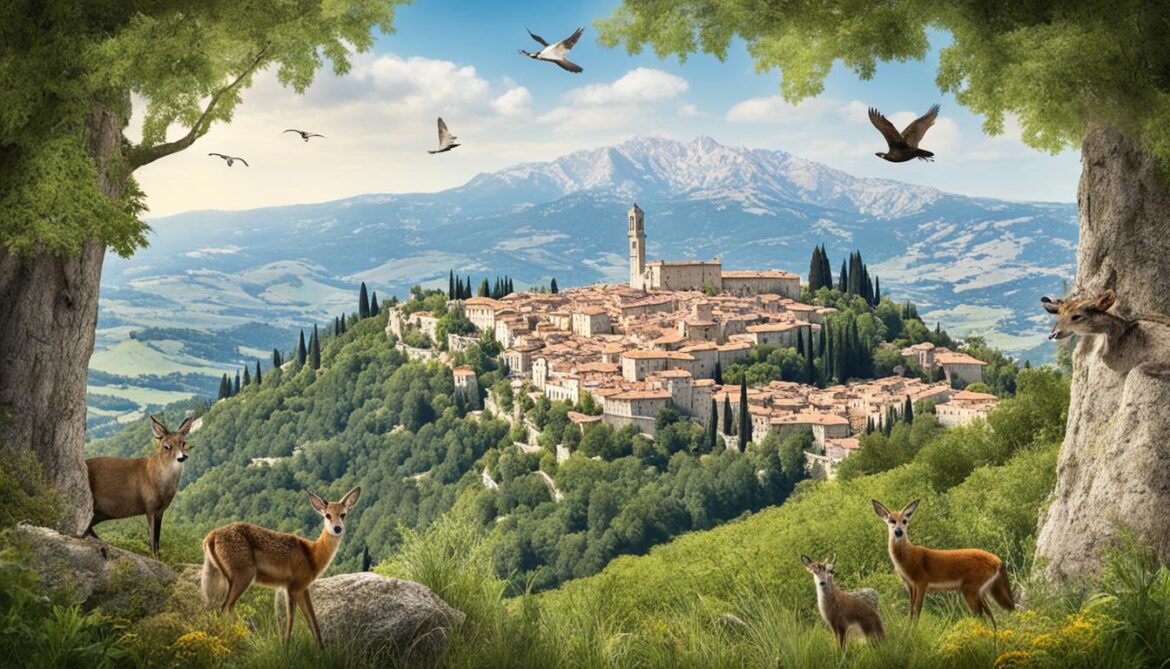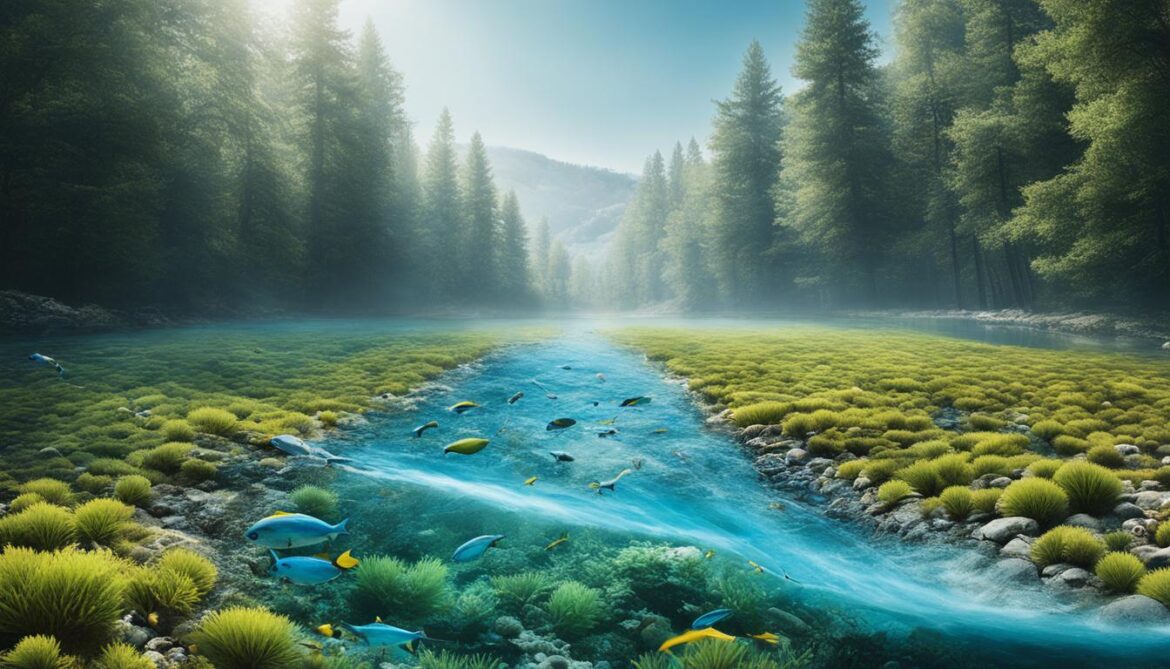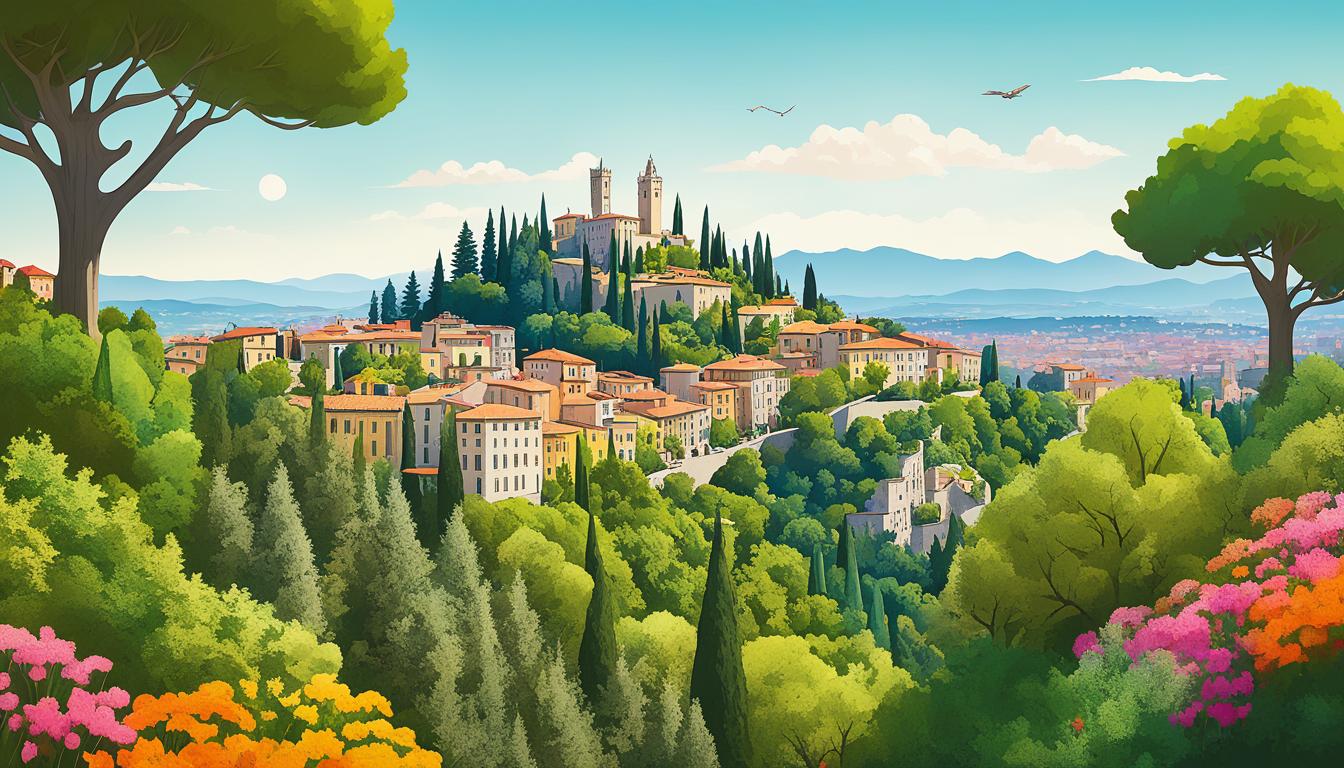Did you know that despite its small size, San Marino boasts a remarkable level of biodiversity? Located on the Italian peninsula, this tiny country is home to a diverse range of flora and fauna, making it a hidden gem for environmental conservation and sustainable development.
Key Takeaways:
- San Marino, despite its small size, has a high level of biological, geological, and landscape diversity.
- The country’s unique topography, including limestone cliffs and meandering creeks, adds to its rugged beauty.
- San Marino showcases diverse vegetation types, from woodlands to shrublands, supporting a vibrant undergrowth.
- The country is home to a wide range of wildlife, including amphibians, birds, mammals, and reptiles.
- Conservation efforts, protected areas, and collaboration with international organizations are key to preserving San Marino’s biodiversity.
Geological and Landscape Diversity in San Marino
San Marino’s territory boasts a remarkable range of geological and landscape features, contributing to its stunning biodiversity. The country is renowned for its small steep valleys, meandering creeks, and magnificent limestone cliffs. One distinctive geological highlight is the Valmarecchia rock slabs, which create an indented and diverse orography across the land. This unique topography adds a ruggedness and raw beauty to the landscape, captivating nature enthusiasts and geology aficionados alike.
Landscape Diversity: From Valleys to Cliffs
The landscape of San Marino showcases a captivating variety, from the charm of its small steep valleys to the grandeur of its limestone cliffs. These diverse features contribute to the overall beauty and appeal of the country, attracting visitors from around the world.
Geological Diversity: Valmarecchia Rock Slabs
One prominent geological characteristic of San Marino is the Valmarecchia rock slabs. These slabs, with their indented and heterogeneous structure, are a testament to the geological processes that have shaped the land over time. They offer a unique glimpse into the fascinating geological history of the region.
“San Marino’s geological and landscape diversity creates a captivating environment that appeals to nature enthusiasts and geology aficionados.”
The ruggedness and raw beauty of San Marino’s landscape, coupled with its geological diversity, make it a truly captivating environment. The diverse array of geological formations and enchanting natural features contribute to the country’s overall allure and create an unforgettable experience for visitors.
Vegetation Types and Flora in San Marino
San Marino boasts a diverse range of vegetation types, contributing to its rich and vibrant biodiversity. The woodlands in the country are predominantly dominated by oaks and other broadleaved trees, such as Quercus pubescens and Fraxinus ornus. These majestic trees create a lush canopy, providing shelter and habitat for numerous plant and animal species.
Shrublands and similar lands are also prevalent throughout San Marino, offering a haven for a variety of beautiful plant species. These shrublands support a vibrant undergrowth, adorned with plants like hawthorn and dogwood, adding bursts of color to the natural surroundings.
The diverse flora in San Marino plays a crucial role in sustaining the abundant wildlife found in the country. The vegetation provides food, shelter, and protection for numerous species, ensuring a harmonious and balanced ecosystem.

From the towering oaks of the woodlands to the delicate blossoms of shrublands, San Marino’s flora paints a vivid tapestry across the landscape. The varied and enchanting vegetation types create an awe-inspiring experience for visitors and a nurturing home for the numerous species that call San Marino their habitat.
The table below showcases some of the prominent flora found in San Marino:
| Flora Types |
Description |
| Oaks |
Dominant trees in the woodlands, providing shade and habitat |
| Broadleaved Trees |
Including Quercus pubescens and Fraxinus ornus, contributing to the lush canopy |
| Shrubs |
Hawthorn, dogwood, and other species creating bursts of color in shrublands |
The flora of San Marino is a testament to nature’s resilience and beauty, reminding us of the importance of preserving and protecting this stunning biodiversity.
Fauna and Wildlife in San Marino
San Marino is home to a diverse range of fascinating fauna and wildlife, showcasing the country’s vibrant biodiversity. From mesmerizing amphibians and beautiful birds to enchanting mammals and captivating reptiles, San Marino’s wildlife is a true testament to the rich natural heritage of the region.
One notable species found in San Marino is the South European Nase (Chondrostoma genei), known for its remarkable appearance and specific habitat preferences. These unique creatures contribute to the ecological balance and biodiversity of the country.
However, it is important to note that some of these remarkable species are currently endangered or critically endangered. This highlights the urgent need for comprehensive conservation efforts to protect and preserve their habitats.
Conservation initiatives play a crucial role in safeguarding the fauna and wildlife in San Marino, ensuring the survival and well-being of these incredible creatures. Efforts to preserve their natural habitats and mitigate human-induced threats are key pillars of conservation measures in the country.

Conservation is vital in preserving the diversity of San Marino’s fauna and wildlife. Every effort counts in safeguarding their future and maintaining the delicate balance of our natural world.
Threats to Biodiversity in San Marino
The biodiversity in San Marino faces several threats that pose significant challenges to its preservation and conservation. These threats include:
Habitat Loss and Fragmentation
Habitat loss and fragmentation due to urbanization and intensive land use jeopardize the survival of many species in San Marino. As urban areas expand and human activities intensify, natural habitats are being destroyed or transformed, leading to the displacement and isolation of wildlife populations. This fragmentation disrupts ecological connectivity, limiting gene flow and reducing overall biodiversity.
Alteration of Ecosystems in Running Waters
The alteration of ecosystems in running waters further endangers the biodiversity of San Marino. The dispersion of organic waste and modification of riverbeds contribute to the degradation of aquatic habitats, negatively impacting the diverse array of species that rely on these ecosystems for their survival. This includes fish, amphibians, and invertebrates that play vital roles in maintaining the health and balance of aquatic environments.
“The alteration of ecosystems in running waters contributes to the degradation of aquatic habitats, negatively impacting the diverse array of species that rely on these ecosystems for their survival.”
To illustrate the severity of these threats, here is a table highlighting the extent of habitat loss, fragmentation, and alteration of ecosystems in running waters in San Marino:
| Threats |
Impact on Biodiversity |
| Habitat Loss and Fragmentation |
Displacement and isolation of wildlife populations, reduced genetic diversity, and decreased habitat availability for various species. |
| Alteration of Ecosystems in Running Waters |
Degradation of aquatic habitats, decline in fish and amphibian populations, disruption of food chains, and loss of biodiversity in water-dependent ecosystems. |
The consequences of these threats are evident in the endangerment and extinction of certain species in San Marino. Urgent conservation efforts are required to mitigate these risks and protect the rich biodiversity of the country for future generations.

Conservation Efforts in San Marino
San Marino is committed to protecting and conserving its rich biodiversity through various conservation initiatives. These efforts aim to safeguard the unique ecosystems and natural heritage of the country for future generations.
Establishment of Protected Areas
One of the key conservation initiatives in San Marino is the establishment of protected areas. These designated areas play a crucial role in preserving the diverse habitats and species found within the country. By creating protected areas, San Marino ensures the long-term conservation of sensitive ecosystems and helps maintain the ecological balance.
Habitat Restoration Projects
In addition to protected areas, San Marino actively engages in habitat restoration projects. These projects focus on repairing and revitalizing degraded habitats, such as forests, wetlands, and grasslands. By restoring these habitats to their natural state, San Marino enhances biodiversity, provides crucial habitats for wildlife, and improves overall ecosystem health.
San Marino Naturalistic Centre
The San Marino Naturalistic Centre plays a vital role in conservation efforts by conducting extensive research and monitoring activities. Through scientific studies and data collection, the center gathers valuable information about the country’s flora and fauna, their populations, and their habitats. This research helps inform conservation strategies and supports evidence-based decision-making.
Collaboration with International Organizations
San Marino recognizes the importance of global cooperation in biodiversity conservation. The country actively collaborates with international organizations and experts to exchange knowledge, share best practices, and implement effective conservation strategies. This collaboration strengthens San Marino’s conservation efforts and facilitates the exchange of expertise and resources.
San Marino’s dedication to conservation initiatives, such as the establishment of protected areas, habitat restoration projects, research and monitoring, and collaboration with international organizations, showcases the country’s commitment to preserving its natural heritage and ensuring the long-term sustainability of its ecosystems.
By actively conserving and protecting its biodiversity, San Marino aims to create a sustainable future where both human and natural systems thrive harmoniously.

Conservation Efforts in San Marino
| Conservation Initiatives |
Description |
| Establishment of Protected Areas |
Designation of protected areas to preserve sensitive ecosystems and species habitats. |
| Habitat Restoration Projects |
Revitalization of degraded habitats to enhance biodiversity and ecosystem health. |
| San Marino Naturalistic Centre |
Undertakes research and monitoring activities to gather vital data for conservation efforts. |
| Collaboration with International Organizations |
Partnership with global organizations and experts to strengthen conservation strategies. |
National Biodiversity Strategy and Action Plan in San Marino
Although San Marino does not have a specific National Biodiversity Strategy and Action Plan, the country has implemented various conservation initiatives to protect its diverse ecosystem.
“Conservation initiatives are vital to safeguard the rich biodiversity of San Marino and ensure its preservation for future generations,” says Dr. Maria Rossi, an environmental expert.
One notable conservation initiative is the Agro-Environmental Plan, which promotes eco-friendly agricultural practices to minimize the impact on the environment and preserve biodiversity. By adopting sustainable farming techniques that reduce the use of harmful pesticides and optimize resource management, farmers in San Marino contribute to the protection of natural habitats and the preservation of species diversity.
The San Marino Agenda 21 Coordination organizes training programs and awareness-raising campaigns to promote sustainable development and environmental stewardship. These initiatives aim to educate the public about the importance of biodiversity conservation and encourage individuals to take proactive steps in their daily lives to minimize their ecological footprint.

Training Programs and Awareness-Raising Campaigns
The training programs organized by the San Marino Agenda 21 Coordination focus on providing individuals with the knowledge and skills necessary to contribute to biodiversity conservation. These programs cover various topics, from sustainable land management practices to wildlife protection and habitat restoration. Through these training initiatives, participants gain a deeper understanding of the interconnected nature of ecosystems and their role in preserving biodiversity.
The awareness-raising campaigns aim to engage the general public and raise awareness about the importance of biodiversity conservation. These campaigns utilize various communication channels, including social media, educational workshops, and community events, to disseminate information and inspire action. By fostering a sense of environmental responsibility and highlighting the benefits of biodiversity conservation, these campaigns encourage individuals to become advocates for the protection of San Marino’s unique natural heritage.
| Conservation Initiatives |
Description |
| Agro-Environmental Plan |
Promotes eco-friendly agricultural practices to minimize environmental impact and preserve biodiversity. |
| Training Programs |
Equips individuals with the knowledge and skills necessary for biodiversity conservation. |
| Awareness-Raising Campaigns |
Engages the public and raises awareness about the importance of biodiversity conservation. |
Status and Trends of Biodiversity in San Marino
San Marino, despite its small size, possesses a remarkable level of biological, geological, and landscape diversity. The country’s unique geographical features contribute to its rich biodiversity, attracting nature enthusiasts and researchers alike.
However, San Marino also faces challenges that impact the status of biodiversity. Habitat loss, driven by factors such as urbanization and intensive land use, poses a significant threat to the country’s ecosystems. This loss of natural habitats disrupts the delicate balance of biological diversity within the region.
The intensification of land use, driven by human activities, further exacerbates the situation. The alteration and degradation of ecosystems, particularly in running waters, harm the native flora and fauna.
These factors collectively lead to a decline in biodiversity, highlighting the urgent need for conservation efforts. To safeguard the rich biological, geological, and landscape diversity, it is crucial to adopt sustainable practices and implement effective conservation measures.
Lack of sustainable practices and uncontrolled urbanization threaten the biological and geological diversity of San Marino. Conservation efforts are essential to protect the diverse ecosystems and ensure a sustainable future for the country.
To address these challenges, it is crucial to monitor and understand the trends in biodiversity. By tracking changes in biological diversity, geological diversity, and landscape diversity, we gain valuable insights into the status of biodiversity in San Marino.
Conservation initiatives, such as the establishment of protected areas and habitat restoration projects, play a vital role in reversing the negative trends. Collaboration with international organizations and experts further enhances these efforts, promoting knowledge exchange and mutual support.
Trends in Biodiversity
| Biodiversity Type |
Trends |
| Biological Diversity |
Declining due to habitat loss and intensification of land use |
| Geological Diversity |
Fragmentation and alteration due to urbanization |
| Landscape Diversity |
Threatened by habitat loss and degradation |
Conservation Efforts and the Way Forward
Protecting and conserving biodiversity in San Marino requires a multifaceted approach. It involves raising awareness about the importance of biodiversity, implementing sustainable land use practices, and preserving critical habitats.
The government of San Marino, in collaboration with environmental organizations, has been working diligently to enhance conservation efforts. The establishment of protected areas, such as nature reserves and wildlife sanctuaries, safeguards important ecosystems and provides refuge for endangered species.
Furthermore, habitat restoration projects and the implementation of monitoring and research programs contribute to the preservation and sustainable management of biodiversity. These initiatives help inform decision-making processes and enable evidence-based conservation strategies.
The challenges faced by San Marino necessitate continuous commitment and collaboration. By integrating conservation into policy frameworks, fostering interdisciplinary research, and promoting sustainable practices, San Marino can secure a future where biodiversity thrives.

In conclusion, while San Marino may be small in size, it boasts a rich and diverse array of biological, geological, and landscape features. However, the threats of habitat loss and intensification of land use are jeopardizing this precious biodiversity. By prioritizing conservation efforts and embracing sustainable practices, San Marino can safeguard its natural heritage for generations to come.
Measures to Enhance Implementation of the Convention
San Marino is actively taking measures to enhance the implementation of the Convention on Biological Diversity. Although a specific National Biodiversity Strategy and Action Plan has not been prepared, the country has implemented various conservation initiatives, adopted environmental legislation, and established mechanisms for monitoring and reviewing implementation.
The implementation of conservation measures is crucial in safeguarding San Marino’s rich biodiversity and promoting sustainable practices. These initiatives focus on protecting the diverse ecosystems and species found within the country’s borders.
In addition to conservation efforts, San Marino recognizes the importance of legislation as a means to ensure the long-term preservation of biodiversity. Environmental laws play a vital role in regulating human activities and preventing further degradation of natural habitats.
Monitoring and review mechanisms are also in place to assess the effectiveness of conservation strategies and identify areas that require further intervention. Regular evaluation allows for adjustments and improvements to be made, ensuring the protection of biodiversity remains a top priority.
Funding plays a significant role in supporting conservation initiatives. By allocating resources towards biodiversity projects, San Marino demonstrates its commitment to preserving the natural heritage of the country.
Capacity-building is another essential aspect of enhancing the implementation of the Convention. San Marino invests in building the skills and knowledge necessary for effective biodiversity conservation. By equipping individuals and organizations with the tools they need, the country promotes a sustainable and proactive approach to preservation.
Collaboration and coordination are key to successful biodiversity conservation. San Marino actively engages with international organizations, experts, and stakeholders to exchange knowledge, share best practices, and foster global cooperation in protecting and conserving biodiversity.
“Effective implementation of conservation measures, supported by robust legislation, funding, and capacity-building efforts, is essential in preserving the unique and valuable biodiversity of San Marino.”
Conclusion
San Marino’s rich biodiversity and diverse ecosystems are invaluable for the country’s ecological sustainability and environmental conservation. The efforts made by San Marino, such as establishing protected areas and collaborating with international organizations, demonstrate a strong commitment to preserve its natural heritage. However, to ensure the long-term protection of San Marino’s biodiversity and the built environment, continued conservation measures and sustainable practices are crucial.
By implementing conservation initiatives and promoting sustainable development, San Marino aims to safeguard its unique flora and fauna for future generations. The establishment of protected areas not only preserves valuable habitats but also allows for the restoration of degraded ecosystems. Collaborations with international organizations enable knowledge-sharing and the adoption of best practices in biodiversity conservation.
To maintain the delicate balance between development and environmental protection, ongoing efforts are needed. By embracing eco-friendly practices and sustainable urban planning, San Marino can mitigate the threats of habitat loss, fragmentation, and intensive land use. These measures will help foster a harmonious coexistence between human activities and the preservation of the country’s biodiversity, ensuring a sustainable and resilient future for San Marino’s natural ecosystems.
FAQ
What is San Marino Biodiversity and the Built Environment?
San Marino Biodiversity and the Built Environment refers to the relationship between the ecological diversity of San Marino and its urban development. It encompasses the conservation of biodiversity and the promotion of sustainable development in the country.
What is the geological and landscape diversity in San Marino?
San Marino boasts a diverse geological landscape, including small steep valleys, meandering creeks, and imposing limestone cliffs. The Valmarecchia rock slabs are a prominent geological feature. These features contribute to the rugged and raw beauty of San Marino’s natural environment.
What are the different vegetation types and flora in San Marino?
San Marino exhibits various vegetation types, predominantly woodlands dominated by oaks and other broadleaved trees such as Quercus pubescens and Fraxinus ornus. Shrublands and other lands host a variety of plant species, including hawthorn and dogwood, adding vibrant colors to the landscape.
What kind of fauna and wildlife can be found in San Marino?
San Marino is home to a diverse range of fauna and wildlife, including amphibians, birds, mammals, and reptiles. The country hosts various species, such as the South European Nase (Chondrostoma genei), some of which are endangered or critically endangered. Conservation efforts are crucial for the protection of these species.
What are the threats to biodiversity in San Marino?
Biodiversity in San Marino faces threats such as habitat loss and fragmentation due to urbanization and intensive land use. The alteration of ecosystems in running waters, caused by the dispersion of waste and modification of riverbeds, is also a significant concern.
What conservation efforts are being implemented in San Marino?
San Marino has implemented various conservation measures, including the establishment of protected areas, habitat restoration projects, and research and monitoring conducted by the San Marino Naturalistic Centre. Collaboration with international organizations further strengthens these efforts.
Does San Marino have a National Biodiversity Strategy and Action Plan?
San Marino does not have a specific National Biodiversity Strategy and Action Plan. However, the country has implemented conservation initiatives such as the Agro-Environmental Plan, training programs, and awareness-raising campaigns to promote sustainable development and environmental stewardship.
What is the status and trends of biodiversity in San Marino?
The status of biodiversity in San Marino is diverse, including biological, geological, and landscape diversity. However, threats such as habitat loss and intensification of land use have negatively impacted biodiversity. It is crucial to implement conservation efforts and sustainable practices to protect San Marino’s diverse ecosystems.
What measures are being taken to enhance the implementation of the Convention on Biological Diversity in San Marino?
While San Marino has not prepared a specific National Biodiversity Strategy and Action Plan, the country has implemented conservation initiatives, adopted environmental legislation, and established mechanisms for monitoring and reviewing implementation. San Marino is committed to strengthening its efforts in biodiversity conservation through legislation, funding, capacity-building, and coordination.
What is the significance of San Marino Biodiversity and the Built Environment?
San Marino Biodiversity and the Built Environment are essential for ecological sustainability and environmental conservation. Protecting biodiversity and promoting sustainable development are crucial for preserving the natural heritage of San Marino for future generations.
Source Links
























Post comments (0)